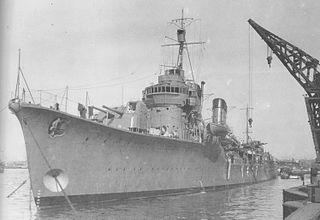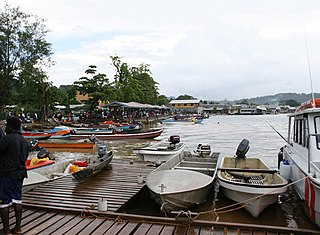
Solomon Islands is a sovereign state in the Melanesia subregion of Oceania in the western Pacific Ocean. This page is about the history of the nation state rather than the broader geographical area of the Solomon Islands archipelago, which covers both Solomon Islands and Bougainville Island, a province of Papua New Guinea. For the history of the archipelago not covered here refer to the former administration of the British Solomon Islands Protectorate, the North Solomon Islands and the History of Bougainville.

A PT boat was a motor torpedo boat used by the United States Navy in World War II. It was small, fast, and inexpensive to build, valued for its maneuverability and speed but hampered at the beginning of the war by ineffective torpedoes, limited armament, and comparatively fragile construction that limited some of the variants to coastal waters. In the US Navy they were organized in Motor Torpedo Boat Squadrons (MTBRONs).

PT-109 was an 80-foot Elco PT boat last commanded by Lieutenant John F. Kennedy, future United States president, in the Solomon Islands campaign of the Pacific theater during World War II. Kennedy's actions in saving his surviving crew after PT-109 was rammed and sunk by a Japanese destroyer earned him several commendations and made him a war hero. Back problems stemming from the incident required months of hospitalization at Chelsea Naval Hospital and plagued him the rest of his life. Kennedy's postwar campaigns for elected office referred often to his service on PT-109.

Tulagi, less commonly known as Tulaghi, is a small island in the Solomon Islands, just off the south coast of Ngella Sule. The town of the same name on the island was the capital of the British Solomon Islands Protectorate from 1896 to 1942 and is today the capital of the Central Province. The capital of what is now the state of Solomon Islands moved to Honiara, Guadalcanal, after World War II.

PT 109 is a 1963 American Technicolor Panavision biographical war film depicting the actions of John F. Kennedy as an officer of the United States Navy in command of Motor Torpedo Boat PT-109 in the Pacific theater of World War II. The film was adapted by Vincent Flaherty and Howard Sheehan from the book PT 109: John F. Kennedy in World War II by Robert J. Donovan, and the screenplay was written by Richard L. Breen. Cliff Robertson stars as Kennedy, and the film features performances by Ty Hardin, James Gregory, Robert Culp and Grant Williams.

The Battle of Blackett Strait was a naval battle of the Pacific campaign of World War II, fought on 6 March 1943 in the Blackett Strait, between Kolombangara and Arundel Island in the Solomon Islands. The battle was a chance encounter between two Japanese destroyers that had been undertaking a resupply run to Vila and a U.S. Navy force of three light cruisers and three destroyers that had been tasked with bombarding the Japanese shore facilities around Vila. The two forces clashed as the Japanese destroyers were withdrawing through the Kula Gulf. In the short battle that followed the two Japanese destroyers were sunk, after which the U.S. ships completed their bombardment of Vila before returning to their base.

Amagiri was the 15th of 24 Fubuki-class destroyers, built for the Imperial Japanese Navy following World War I. When introduced into service, these ships were the most powerful destroyers in the world. They served as first-line destroyers through the 1930s, and remained formidable weapons systems well into the Pacific War. She is most famous for ramming the PT-109 commanded by Lieutenant John F. Kennedy, who would later become the 35th President of the United States.

The Coastwatchers, also known as the Coast Watch Organisation, Combined Field Intelligence Service or Section C, Allied Intelligence Bureau, were Allied military intelligence operatives stationed on remote Pacific islands during World War II to observe enemy movements and rescue stranded Allied personnel. They played a significant role in the Pacific Ocean theatre and South West Pacific theatre, particularly as an early warning network during the Guadalcanal campaign.

The British Solomon Islands Protectorate was first declared over the southern Solomon Islands in June 1893, when Captain Herbert Gibson of HMS Curacoa, declared the southern islands a British protectorate.
Kennedy Island, is a 1.17 hectares, uninhabited island in Solomon Islands that was named after John F. Kennedy, following an incident involving Kennedy during his World War II naval career. Kennedy Island lies 15 minutes by boat from Gizo, the provincial capital of the Western Province of Solomon Islands.

Blackett Strait is a waterway in the Western Province of the Solomon Islands. It lies between the islands of Kolombangara to the north, and Arundel Island (Kohinggo) to the south. It connects Vella Gulf to the west with Kula Gulf to the east. It is almost certainly named after Lt. Frederick Arthur Blackett (1846-1880), the youngest son of Sir Edward Blackett 6th Bt., who served on HMS Thalia as part of the China Station from 1872 to 1873.

Gizo is the capital of the Western Province in Solomon Islands. With a population of 7,177, it is the third largest town in the country. It is situated on Ghizo Island approximately 380 kilometres west-northwest of the capital, Honiara, and is just southwest of the larger island of Kolombangara.

Rendova is an island in Western Province, in the independent nation of Solomon Islands, in the South Pacific, east of Papua New Guinea.
Arthur Reginald Evans, DSC was an Australian coastwatcher in the Pacific Ocean theatre in World War II. He is chiefly remembered for having played a significant part in the rescue of future US President John F. Kennedy and his surviving crew after their motor torpedo boat, PT-109, was sunk by the Japanese in August 1943.
Biuku Gasa and Eroni Kumana were Solomon Islanders of Melanesian descent who found John F. Kennedy and his surviving PT-109 crew following the boat's collision with the Japanese destroyer Amagiri near Plum Pudding Island on 1 August 1943. They were from the Western Province of the Solomon Islands.
"PT-109" is a 1962 song by Jimmy Dean about the combat service of John F. Kennedy and the crew of the PT-109 in World War II. The boat was famous even before Kennedy ran for office, because Kennedy and most of the crew had survived after it was rammed and cut in two by a Japanese destroyer. After several days on a tiny uninhabited island, Kennedy and the crew were rescued by two native Solomon Islanders—Biuku Gasa and Eroni Kumana, part of an allied Coastwatchers team led by Australian Reg Evans—although the islanders are not mentioned in the song.
The Search for Kennedy's PT 109 is a National Geographic television special and video on DVD, directed by Peter Getzels. It documents the true story of John F. Kennedy's PT-109 from World War II, and the successful search for the ship by Dr. Robert Ballard.

PT-59 / PTGB-1 was an S-Class Patrol Torpedo boat of the United States Navy, built by the Electric Launch Company of Bayonne, New Jersey. The boat was laid down as Motor Boat Submarine Chaser PTC-27, and was reclassified as BPT-11 when assigned to transfer to Britain under Lend-Lease. However, this was cancelled, and she was reclassified as PT-59 prior to launch on 8 October 1941, and was completed on 5 March 1942.
Naru Island is a small island in the New Georgia Islands of Western Province, in the independent nation of Solomon Islands. About 600 metres long and up to 300 metres wide. Coastline is about 1,65 km.

PT 109: An American Epic of War, Survival, and the Destiny of John F. Kennedy is a non-fiction book by best-selling author William Doyle released by Harper-Collins in 2015 that describes the ramming and sinking of future President John F. Kennedy's Patrol Torpedo Boat 109 by the Japanese destroyer Amagiri off the coast of Kolombangara Island in the Solomon Island Chain on August 2, 1943. The book also chronicles the crew's difficult three mile swim to Plum Pudding Island and the subsequent week of living there and on adjacent Olasana Island until Patrol Torpedo Boat PT-157 rescued them on August 8. The novel also discusses the considerable impact the experience had in helping to launch Kennedy's political career, beginning with his election to the House of Representatives in 1946. JFK's aid David Powers has written, "without PT 109, there never would have been a President John F. Kennedy".












